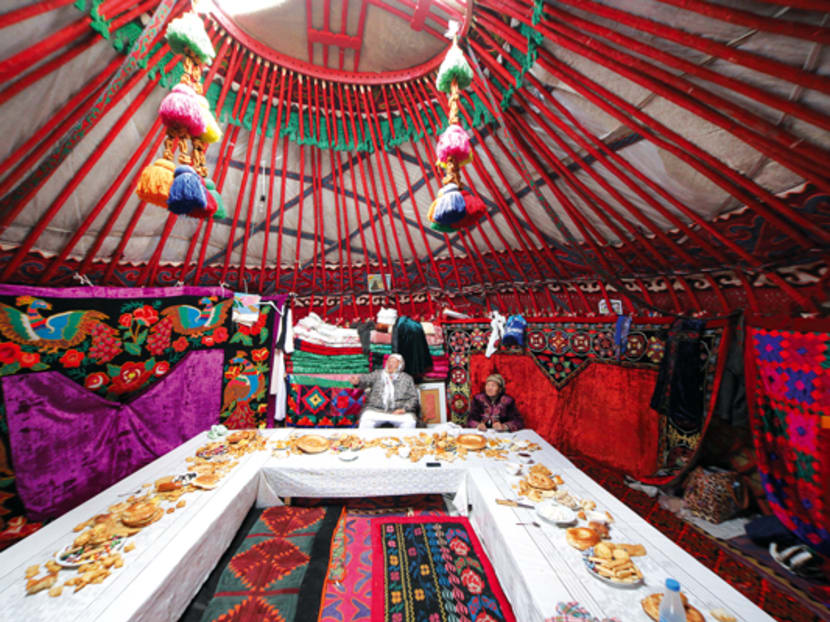World nomad games
On the shores of Lake Issyk Kul in Kyrgyzstan, riders thundered across the plains, while men wearing tall kalpak hats strutted around with falcons in hand. Throat singing and twangy strings echoed in the distance, amidst folkloric dancing, tightrope shows and eagle hunting. As the opening ceremony rolled along, the announcer said: “If Genghis Khan were alive, he’d want to be here.”

A taste of nomadic life in Kyrgyzstan. PHOTO: Nellie Huang
On the shores of Lake Issyk Kul in Kyrgyzstan, riders thundered across the plains, while men wearing tall kalpak hats strutted around with falcons in hand. Throat singing and twangy strings echoed in the distance, amidst folkloric dancing, tightrope shows and eagle hunting. As the opening ceremony rolled along, the announcer said: “If Genghis Khan were alive, he’d want to be here.”
This was the World Nomad Games — a six-day event often described as the Olympics for the nomads. I had heard about the games on my first visit to Kyrgyzstan in 2014 and conversations with local friends about it had piqued my interest. The World Nomad Games wasn’t all about the sports; the event also aimed to preserve the disappearing nomadic cultures.
Last year, I joined in as a spectator among a crowd of over 1,200 people from 62 countries from India to Africa, and amid 300 yurts set up on the Kyrchyn jailoo (pasture) as an Ethno Village.
TRAVELLING BACK IN TIME
The Hippodrome was the centre stage for various horse-related events, but as a spectator, I was also spoilt for choice among indoor sports such as alysh and goresh (different kinds of wrestling), and intellectual board games such as mangala, which dates back to the 16th century.
The star event at the games was kok-boru, a fiercely competitive form of polo with hundreds of years of history, where two teams battle for a headless goat or sheep carcass.
First, the players had to manoeuvre their horses to gain possession of the carcass. Then they’d swoop down to grab a leg and pull it up. This was harder than it seemed as the carcass can weigh up to 68kg.
The goat is tugged back and forth until a player grabs hold of it, races towards the goal and dunks the goat in to score. At the end of the game, the winning team feasts on the goat.
Last year, the highly anticipated kok-boru finals was between Kyrgyzstan and Kazakhstan. The Hippodrome was alive with supporters waving flags and cheering on their teams. I felt privileged to witness Kyrgyzstan clinch the title.
KYRCHYN LIFE
The most memorable experience, however, was meeting with the locals at the Ethno Village. Putting on their finest traditional wear, they had come from afar, travelling days to reach Lake Issyk Kul from Kyrgyzstan’s seven regions and two cities of Bishkek and Osh to put up yurts and showcase their traditional way of life.
The Kyrchyn Ethno Village sat on miles of green pastures framed by the snow-peaked Ala-Too mountain.
All around me were women wearing tall, bejewelled headdresses, children playing on bamboo selkinchek (two-men swings) and Kyrgyz men in embroidered or armoured outfits, having a go at archery, salbuurun (eagle hunting), and hunting using special Taigan dogs.
AT HOME WITH THE LOCALS
I lost count of the number of times I was invited into a yurt by the locals. They were all eager to meet foreigners, share stories and feed us delicious sweets and naan bread.
We talked about their families, their hometowns and their disappearing way of life. They barely have as much as what we do but work hard to make a difference to their communities. There was Zura from the Naryn Province, who inspired me with her strength and wisdom. And the two women Benoka and Alima, who generously gave presents to my family without expecting anything in return.
“No words can express how proud I am of our Kyrgyz culture, being here at the World Nomad Games,” said Murat, a teacher in his 50s.
He had travelled for days to get here and had brought his falcon along. Murat’s grandfather and father practised falcon hunting and he hunted during his spare time to keep the family tradition alive.
As the ceremony drew to a close, spectacular fireworks lit up the sky. The next games will be held in 2018 in Kyrgyzstan and I for one, will be back to experience the extraordinary event.
TRAVEL TIPS:
Getting there
Uzbekistan Airways and Turkish Airlines fly from Singapore to Bishkek, Kyrgyzstan’s capital city, with one stopover. Singaporean passport-holders do not need a visa to enter Kyrgyzstan.
When to go
Visit in summer, which runs from June to September. As Kyrgyzstan is a mountainous country, winter can be harsh from November to March, with frequent electricity black-outs and roadblocks due to snowfall.
Budget
S$1 is approximately 48 Kyrgyzstani Soms. A restaurant meal costs about S$5 and accommodation can range from S$20 for a hostel dorm bed to S$120 for a hotel room per night.





